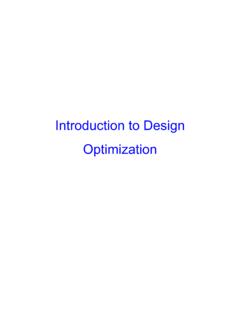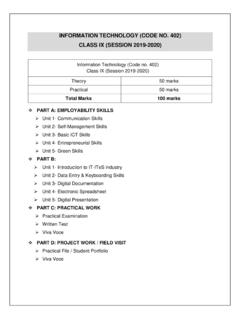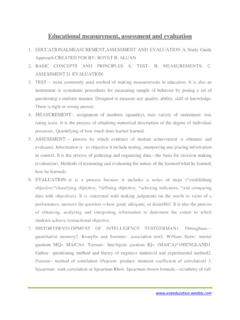Transcription of 5 Geometric Modeling.ppt - UVic.ca
1 Geometric ModelingIntroduction Geometric modelingis as important to CAD as governing equilibrium equations to classical iifildhi dth lengineering fields as mechanics and thermal fluids. 9intelligent decision on the types of entities necessary9intelligent decision on the types of entities necessary to use in a particular model to meet certain Geometric requirements such as slopes and/or of unexpected results9evaluations of CAD/CAM systems9innovative use of the tools in particular applications9innovative use of the tools in particular of new attributes, or modify the obtained models to benefit new engineering of terminology The Role of Geometric modeling in aThe Role of Geometric modeling in a CAD SystemComputerDisplayMathematicalreprese ntation(Database)UserInterfaceDrawingGen erationGeometricGenerationAli dDetermineDetermineModelingTechniqueAnal ysis andManufacturingGeneral RequirementsGeneral Requirements Complete part representation includingtopologicalComplete part representation including topological and geometricaldata Geometry: shape and dimensions Topology: the connectivity and associativityof the object entities; it determines the relational information between object entitiesinformation between object entities Able to transfer data directly from CAD to CAE and CAM.
2 Support various engineering applications, such as mass properties, mechanism analysis , FEA/FEM and tool path creation for CNC and so ontool path creation for CNC, and so and GeometrypgyyComments on Geometric modeling Geometric modeling is only a meansnot the goalin iliddttth Engineering analysisneeds product geometry; the degree of detaildepends on the analysis procedure that utilizes the There is nomodel that is sufficientto study all behavioral aspects of an engineering component or a systemsystem. Attributes facilitate analysis and grow with applicationsppBasic Geometric modeling TechniquesBasic Geometric modeling Techniques 2-D Projection (Drawings) Wireframe modeling Surface ModelingAltilSf Analytical Surface Free-form, Curved, & Sculptured Surface Solid ModelingSolid modeling Constructive Solid Geometry (CSG) Boundary Representation (B-Rep).
3 Feature Based modeling Parametric modeling Parametric Modeling2-D ProjectionProblems: Training is necessary to understand the drawing Training is necessary to understand the drawing Mistakes often occur Does not support subsequent applications such as fi ill i (FEA)NCfinite element analysis (FEA) or NC part programmingWireframe modeling Developed in 1960s and referred as a stick figure or an edgerepresentation g The word wireframe is related to the fact that one may imagine a wire that is bent to follow the object edges to generate a model. Model consists entirely of points, lines, arcs and circles, conics, and curves. In 3D wireframe model,an object isnotrecorded as asolid.,jInstead the vertices that define the boundary of the object, or theintersections of the edges of the object boundary are recordedas a collection of points and their n tfro ntorfro n tambiguousExample of Wireframe ModelingpgSf MdliSurface modeling A surface modelisa set of faces A surface modelis a set of faces.
4 A surface model consists of wireframeentities that form the basis to create surface entitiesthe basis to create surface entities. In general, a wireframe modelcan be extracted from a surface modelbydeleting or blanking all surface entitiessurface modelby deleting or blanking all surface entities Shape designand representation of complexobjects such as car, ship, and airplane bodies as well as castingsppg Used to be separated, shape modelare now incorporated intosolid models(e g Pro/E)into solid models( Pro/E)Examples of Surface ModelsAltilSfFree-form, Curved, orSculptured SurfaceAnalytical SurfacesSculptured SurfaceElfSfMdlExamples of Surface Models Surface models define only the geometry, no , pgy Shading is possibleShading-by interpreting the polygons Shading -by interpreting the polygons Direction (normal) Spatial order Solid Modelingg The solid modeling technique is based upon the "half-space"concept.
5 P The boundary of the model separates the interiorand exteriorof the modeled object. The object is defined by the volume space contained within the defined boundary of the object. In general speaking, a closed boundary is needed to define a solid lll tliddbitti informationally complete, valid, and unambiguousrepresentation (Spatial addressability) points in space to be classified relative to the object, if it is inside outside or on the objectinside, outside, or on the object store both Geometric and topologicalinformation; can verify whether two objects occupy the same space. improves the quality of design improves visualization and hasimproves the quality of design, improves visualization, and has potential for functional automation and Solid modeling ?Why Solid modeling ?Solid modeling SupportSolid modeling Support Using volume information weight or volume calculation, centroids, moments of iti lltiinertia calculation, stress analysis (finite elements analysis ), heat conduction calculations, dynamic analysis , system dynamics analysisUildbdifti Using volume and boundary information generation of CNC codes, and robotic and assembly simulationFoundation of SOLID modeling ing(Element of Primitives).
6 Half Spaceout Unbounded Geometric entities Each one of them divides the representation space into outinfiniteportions, one filled with materialand the other empty Surfacescan be considered half-space boundariesand half fspaces can be considered directedsurfaces An object is defined by the volume space contained within the defined boundary of the objectthe defined boundary of the objectIntroduces the directioninto the modeling , thus enables the topologicalinformation be stored in a Geometric modelinHalf Spaces By specifying different boundary surface, we can have anyhalf-spaces;out The most commonly used half-spaces are planar, cylindrical, spherical, conical, and toroidal. By combininghalf-spaces (using Boolean ti) ib ildibl k f hioperations) in a building block fashion, various solids can be Spaces Planarhalf-space Cylindricalhalf-space}0:),,{(<=zzyxH}:), ,{(222 RyxzyxH<+=yp}),,{(yyBlock: {( , , ) : 0, 0,0}xyzxWyHandzD<<<< << Cylinder: }0.
7 ,,{(222 HzandRyxzyx<<<+ Example of Half SpacesExample of Half SpacesDifferent Solid modeling TechniquesDifferent Solid modeling Techniques Constructive Solid Geometry(CSG) Sweeping Boundary Representation(B-Rep) Feature-Based modeling - uses feature-based primitives to conduct a design Primitive Instancing- uses large numbers (200 - 300) of primitives" to build object - used for programming NC machine tools (past)machine tools (past) Cell Decomposition, Spatial Enumeration, Octree(connected cubes of varying size) used for irregular objects, image processing, medical applications (CT)Information complete, unambiguous, accurate solid modelConstructive Solid Geometry (CSG) Pre-defined geometricprimitivesPre-defined Geometric primitives Boolean operations CSG tree structure (building process/approach) Geometric Primitives - CSG A collection of pre-defined (low level) Geometric primitives Sweepingof a 2D crosssection in the form ofextrusion Sweepingof a 2D cross-section in the form of extrusionand revolvingare used to define the 3D shape (for uncommon shapes).)}
8 Low Level GtiDimensionsGeometric PrimitivesLocationOrientationDefined GeometricGeometric FeaturesBoolean OperationsBoolean Operationsin CSG Union, U Intersection, n Difference or Subtraction- Difference, or Subtraction, -Un--CSG TreeAlternati e Paths of ModelingAlternative Paths of ModelingA lengthy, lousy processSweepingSweeping can be carried out in two different forms: Extrusion-to produce an object model from a 2D cross-section shape the direction of extrusion and a given depth Advancedshape, the direction of extrusion, and a given depth. Advanced applications include curved extrusion guideline and varying cross-sections. Revolving-to produce a rotation part either in solid or in shell Revolving-to produce a rotation part, either in solid or in shell shape. Revolving a 2D cross-section that is specified by a closed curve around the axis of symmetry forms the model of an axially symmetric is most convenient for solids with translationalor rotationalsymmetry Sweepingrotationalsymmetry.
9 Sweeping also has the capability to guarantee a : spatial sweeping; & varying cross-sectionBoundary Representation (B-rep)Boundary Representation (B-rep) The boundary representation method represents a solidas a pcollection of boundary database records both of the surface geometry and the topological relations among thesetopological relations among these surfaces. Boundary representation does not guaranteethat a group of boundary f(ft l )fsurfaces (often polygons) form a closed solid. The data are also not in the ideal form for model calculations. This representation is used mainly for graphical displays. Many CAD systems have a hybriddt t tibthCSGddata structure, usingboth CSG and B-repat the same time ( Pro/E).BdRt ti(B) Object List----giving object name, a list of all itsboundaryBoundary Representation (B-rep) Object List giving object name, a list of all its boundary surfaces, and the relation to other objectsof the model.
10 Surface List ---- giving surface name, a list of all its component polygons, and the relation to other surfacesof the ,j Polygon List---- giving polygon name, a list of all boundary segmentsthat form this polygon, and the relation to other polygonsof the surface. Boundary List ---- giving boundary name, a list of all line segmentsthat for this boundary, and the relation to other boundarylines of the polygon. Line List---- giving line name, the name of its two end points, and the relation to other linesof the boundary line. Point List---- giving point name, the X, Y and Z coordinatesof the point and, and the relation to other end pointof the , Face, Polygon (Edge Loop),Edge, VertexEuler OperatorsMBFV: Make body face(Edge Loop),Edge, VertexMBFV: Make body, face, vertexMME: Make multi edgesMEF: Make edge, faceKEML: Kill edge, make loopKFMLG: Kill face, make loop, genusFeature-based, Parametric Models Pro/E Feature-based, Parametric Solid modeling system represents the recent advanceof computer Geometric modeling .












